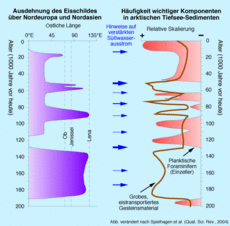In cooperation with national and international partners, the environmental parameters of the Arctic Ocean in the younger geological history are investigated at IFM-GEOMAR. On several expeditions with the German research icebreaker "Polarstern" and other icebreaking research vessels, sediment cores (Fig. 1) were obtained from the arctic subbasins, submarine ridges, and circum-arctic continental margins. Color, composition, and geochemical parameters of the sedimentary sequences and their components reflect the variability of important environmental factors of the ocean. Results of the research at IFM-GEOMAR allowed to reconstruct the history of the arctic ice cover, the uppermost water masses, and the freshwater influx from northern Europe and Asia during the last 200,000 years (Fig. 2). High contents of planktic foraminifers (protozoans) indicate an at least seasonal ice cover and an inflow of Atlantic Water into the Arctic, similar to the present "Gulf Stream". High amounts of coarse, ice-rafted rock particles in the sediments are evidence of large numbers of icebergs which broke off from large, calving ice sheets. Finally, the isotopic composition of of calcareaous planktic foraminifers reveals times of increased freshwater influx from melting glaciers and discharching ice-dammed lakes. The good temporal correlation between the marine geologic data and the history of waxing and waning ice sheets, as revealed from onshore work by other working groups (Fig. 2), is evidence for a close climatic coupling of land and ocean.
Other work in the central Arctic Ocean is dedicated to the last warm period ca. 125,000 years ago, the freshwater runoff from northern Siberia during the last ice age-warm period transition ca. 10-15,000 years ago, and the variability of the Atlantic Water inflow and the ice margin within the present warm period of the Holocene which has lasted now for ca. 10,000 years.




